![]()
labrys,
études féministes/ estudos feministas
juillet/décembre 2012 - julho /dezembro 2012
Among Our Earliest Amazons
Eurasian Priestesses and Warrior-Women
Jeannine Davis-Kimball
“But even as I threatened, so will I do, and give thee fill of blood.” –
Tomyris, Queen of the Massagetae, in Herodotus 1:204:14
Abstract
In the first millennium BCE, as campfire tales were exchanged during the long evening in Silk Road caravanserais, nomadic women warriors may have become the role-model for the mythical Amazons. These tales have a basis in fact as artifacts found in female nomadic burials, dating around 2500 years ago throughout the Eurasian steppes, have allowed us to identify nomadic women of high status: priestesses, warrior women, and warrior-priestesses. This articles analyzes and illustrates the important identifying attributes of these women, and pose some hypotheses as to how and why these women attained their positions of prestige, and why these women of high status were so vitally important to the survival of their tribes.
key-words:priestesses, warrior women, and warrior-priestesses.
Introduction
One of the most popular legends displayed in Classical Greek art is the Twelve Labors of Hercules, the heroic half-mortal son of Zeus. The ninth adventure has Hercules ordered to capture the Amazon queen Hippolyte’s sacred girdle. In the battle that ensues—for the queen does not easily surrender—she is slain and her Amazonian sisters are driven from their homeland. In other versions of the myth, Greek heroes, such as Theseus who always has supernatural strength, attack and gain dominance over the formidable female warriors. Thus, the Amazons, perhaps our first (mythical) warrior women, were such fearsome enemies that no mortal man could achieve supremacy.
One can well imagine that the Amazonian myths may have originated as travelers, who had encountered actual warrior women along the numerous silk roads that traversed the steppes from southern Europe to points eastward into China, sat around nightly camp fires spinning tales of far-off lands, of women who rode horseback, shot arrows, killed men, and with their supernatural powers, manipulated great nomadic chieftains.
Herodotus, the “Father of History” who lived in Odessa around 450 BCE, recounts the genesis of a nomadic tribe (again from informants who plied the Silk Road), the Sauromatians, who were the descendants of these Amazons and Scythian nomads. The Amazons had shipwrecked on the shores of the North Black Sea and encountered the Scythians. A battle ensued. When, at the end of the day the Scythians examined bodies of some of the fallen, they discovered to their amazement they were fighting women. What to do? They sought advice from their elders, who in turn counseled them not to fight but rather to marry. This came to pass. However, the Amazons promptly declared they could never live as the Scythian women did, nor could they live in proximity. Thus, the Scythian men collected their inheritances and the “new tribe” migrated to the north and east. (Herodotus, IV: 110-117.) It is in the steppes to the northeast of Scythian territory that multitudes of Sauromatian and the later dated Sarmatian kurgans (burial mounds) dotted the landscape.
In the sixth century BCE, Tomyris was the warrior queen of the Massagetae, another nomadic tribe occupying a sizeable territory in Central Asia. Herodotus recounts an historical battle between Cyrus the Great, the first Achaemenid Persian king, and Tomyris and her warriors. It seems that Cyrus had decided to annex to his kingdom the Massagetae territory beyond the Araxes River (probably the Volga). Although she had warned Cyrus not to enter her territory, he did not take Tomyris seriously. With the intent of tricking the queen’s warriors, Cyrus then prepared a great feast with skins of wine laid out for the young nomadic royalty. Some, including Tomyris’ son fell for the bait. Now, thinking that her warriors were useless in battle, Cyrus and his army crossed the Araxes, and to his great surprise, Tomyris ferociously attack the Persians. The battle was so fiercely fought that “There perished the greater part of the Persian army, and there fell Cyrus himself . . .” The queen, so furious that Cyrus had breached her lands and, further, that her son had committed suicide in shame,
“filled a skin with human blood, and sought for Cyrus’ body among the Persian dead; when she found it, she put his head into the skin and spoke these words of insult to the dead man: ‘Though I live and conquer thee, thou has undone me . . . but even as I threatened, so will I do, and give thee thy fill of blood.’ (Herodotus IV, 205-215)
As the early nomadic societies of the first millennium BCE were without written languages, textual sources such as that of Herotodus and other Greek historians were long considered merely tall tales. Patriarchal societies, moreover, from ancient times to present have recorded information that—for the most part—glossed over the roles women played in history. Amazingly though, archaeological excavations beginning in the 19th century, began to gather information that has only recently begun to be extrapolated. These new researches have lent credence to many nomadic traditions recorded around fifteen centuries earlier. But even more amazing, the role of women in the early nomadic societies has, not only been revealed, but has a content dear to our hearts today.
Among the snippets of history that reveal the roles of women in ancient times, we have examined burials ranging geographically from southern Siberia to southern Kazakstan, and from the southern Ural steppes to those of northern Afghanistan. All have commonalities. Mortuary offerings are rich in complex iconography that expresses universal rituals and rites of passage for all Early Iron Age nomads. Ichnographically and stylistically they reveal cultural influence from all points—north, south, east, and west—and that the intermingling of various cultural traits created the dynamism that survived on the Eurasian steppes for more than 2500 years. This is particularly apparent in the artifacts of women of high-status: the priestesses, warrior women, and warrior-priestesses.
It has been suggested that through time women achieved much of their dominance as a result of healing powers. To become healers would have occurred as a natural progression from the long ago era of hunting and gathering. Woman, as the gather, learned the properties of each plant: it use as a foodstuff or its medicinal powers that allowed her to heal. The women also found that hallucinogenic properties of certain plants provided the means to make special journeys into the Otherworld, sometimes burning the plant and inhaling the smoke (Rudenko 1970). Suggesting that universally the nomads used hallucinogenics for ritual purposes, I have seen great clumps of cannabis growing wild in the southern Ural steppes, and a Sarmatian burial at Pokrovka contained a terracotta vessel holding seeds of a hallucinogenic plant.
The use of hallucinogenics is a phenomenon perhaps instrumental in the development of shamanism and may be directly related to women’s work (Davis-Kimball 2004). Ethnographers have noted that the roots of shamanism lie in Paleolithic Siberia where a single term, udagan, is used throughout the region for female shamans, while in contrast male shamans have a variety of names. This would indicate that the first shamans were women, and men took up the profession only much later. With the evolution from either hunter and gatherer or small village farmer into the nomadism, which involved migrations from forest-steppes to steppe environment, women found yet new medicinal plants, allowing them to further their knowledge and augment their skills. It was probably at this time that the evolution from women shamans (udagan) in the more northerly forest-steppes to that of warrior-priestesses in the steppes took place.
Physical and forensic anthropologists have studied the skeletal remains from various Eurasian populations and found that, probably because of higher population density, skeletal remains of sedentary people and nomads belonging to large confederacies show more signs of trauma and disease (Murphy and Davis-Kimball 2001). In contrast, in true nomadic societies made up of smaller groups, severe diseases are essentially non-existence. For example, in the older Pokrovka population group, age 45-65, disease in skeletal material revealed some osteoarthritis (an aging processes) and fusing of the coccyx (trauma from horse riding). The teeth of all age groups were excellent and, amazingly, without caries (the diet was primarily meat and milk). Only very rarely is there an example of a healed or unhealed fracture. Among the skeletal remains of men, 18-40, cause of death was not apparent leading to the conclusion that soft tissue injuries (from fighting?) and infections, including pneumonias, may have been primary causes of death. Women of childbearing age, (16-30), are the most prominent age group in the Pokrovka burials. However, when a woman lived to a “ripe old age” (say 60) she was a ‘reverend ancient one.’ This is true especially if one considers the hazards of a nomadic lifestyle. The elders remain very active, as I have frequently observed. I especially recall in western Chinese one very old Kazak lady rode her horse over the hills to a neighboring aul for an afternoon pleasurable get-together.
Returning to women’s statuses, and their role as extraordinary healers, the need for their skill seems to have been most intense within the circles of great chieftains, who amassed large numbers of tribes and thus contended with denser populations. It follows that by association priestesses and warrior-priestess belonging in these confederacies would be of extraordinary high status because of the value of the numerous abilities to the tribes. And, as archaeology has shown, it is within only a few great ‘tsar’ kurgans that we have found evidence for great priestesses and warrior-priestesses. However, because smaller kurgans were neither so visible on the horizon nor so lucrative when plundered, their contents were preserved for a time when archaeology allowed us to verify our suppositions—that nomadic woman throughout the steppes all enjoyed distinction.
The Briefest Glimpse of Nomadic Life in the 20th Century
When the evolution occurred from sedentary farming to nomadism based upon animal husbandry, women had, by necessity, modified their lifestyle. As a result, their status changed from one of dependency, as found in many sedentary societies, to one in which warrior women, priestesses, and warrior-priestesses played central roles in their world.
Early in my research of steppe peoples, I had been fortunate to be included in the study trip through Mongolia, “Dialogue of the Silk Road,” sponsored by UNECO. We had flown to the provincial capital, Hovd, in western Mongolia and from there I could see to the north the shining glaciers of the Altai Mountains. When I commented on this beautiful scenery, one of our Mongol guides told me that the Kazaks, who still maintained the ancient nomadic life-style tradition, lived there. This was surprising, as I had not realized nomads still existed who followed the ancient traditions. And knowing a little bit about animals, I could not fathom how any nomad could maintain flocks of sheep and horses in such a harsh climate.
Thus, I resolved to delve into this question. Excavations each summer kept me occupied for the next four years. Then in 1966, with the help of two Kazaks, one who provided the invitation and introductions I would need to go to the Altai Mountains and the other, my translator, I traveled for three months in the Altai Mountains, visiting Kazaks at their summer pastures. From them I learned, “how they did it —and how they had done it for more than 2500 years.”
The essence of their lifestyle follows a specific form. During nine to 10 months of the year—from early spring through late fall—the nomads follow the pastures as they green with spring rains then brown as winter approaches. Family life is centered around the animals—sheep, goats, horses, camels, and in the higher altitudes, yak—and the preparation of food, clothing, and shelter. Now isolated from any sedentary society, their animals provide almost all their needs: milk, cheeses, and meat for food, wool and leather from which they fashion clothing, shelter, and harnessing. Specific tasks are assigned with a gender overlap. Generally the person with time performs the task at hand. In the fall, bartering becomes paramount as they exchange wool, meat, and cashmere for a few necessities: salt and tea are at the top of the list followed by hardtack candy, clothing, and possibly a few luxury items for the household.
Horseback riding is paramount to these cultures. Toddlers are placed with a parent on horseback and by the time the boys and girls are six or seven, they are herding or jockeying in the ever-favorite long distant, 15-25 km, horse race.
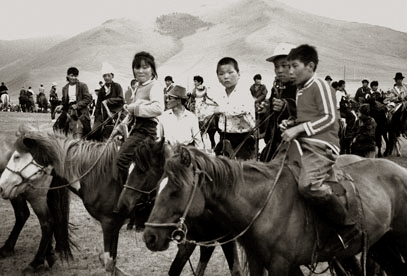
Fig.1. Kazak girls and boys jockey for position during a 25 km race in western Mongolia.
Otherwise young men hang out with their peers or fathers and grandfathers, learning the art of saddlery, leather- and metalworking. Sometimes they herd, learn butchering, but frequently help with the toddlers. Girls as young as six or seven eagerly participate in a plethora of household tasks so by the time they are young adults they are perfectly prepared for survival in this harsh environment. Young women, in addition to learning the arts of establishing and maintaining a household, also herd sheep in the summer pastures.
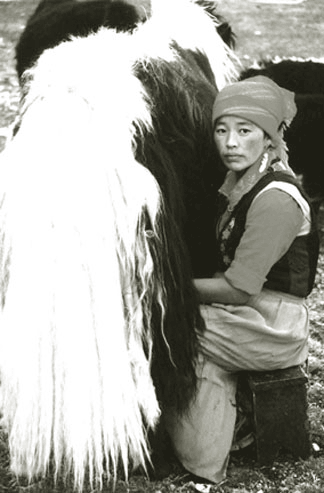
Fig. 2. A Kazak woman milks a yak whose milk she will make into
two kinds of cheese: one for summer eating and another one, cured hard in the sun, for winter.
The entire family, but especially the women, are involved in milking the sheep, horses, and yak several times a day and continually in the summer they make a variety of cheeses for summer and winter consumption. Women, as is their lot, had extras: bearing and nursing the children (Figure 3), daily and long-term food preparation, disassembling and reassembling the yurt (portable housing) at each frequent move, weaving and rope making, readying for rites of passage, and performing these rites.
.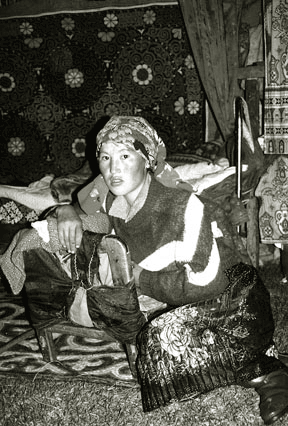
Fig. 3.A young Kazak mother nurses you baby while it is still swaddled in its cradle. Dayan, Bayan Ulgii aimag, Mongolia.
Exogamy is and was practiced: in olden times wives were bought or stolen from other tribes (until recently marriages were arranged but this practice has decreased). Because of the continual threat of raiders young girls become able warriors, defending home, property, and self. By tacit agreement, the chieftainship was given to the most adept; therefore, a woman could also be a chieftain. Moreover they were equals in decision-making that involved yurt or aul, the group of yurts that housed those who lived and traveled together within the tribe or confederacy.
First Millennium BCE Nomads
The southern Ural steppes—the land where Asia greets Europe—are fraught with bitter Siberian winter winds. When Russia, under the great tsar, Peter, expanded eastward, the now transcontinental city, Orenburg on the Ural River, was a mere (but nonetheless vital) military outpost (See Map).
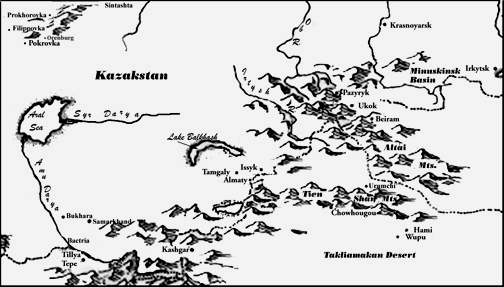
Millennia before the tsarist troops, the vast steppe lands that surround this city teamed during the hot summer months with nomadic tribes now called Sauromatians, as well as the probably genetically unrelated Sarmatians. As was their custom, grazing their herds in the rich grassland, they had brought their dead for burial to this sacred land. Thus, rose a paucity of great, and a multitude of smaller, kurgans—nomadic burial mounds.
During the summer archaeological seasons of 1992-1995, the collaborative American Russian team[1] excavated more than 182 burials at Pokrovka, a site of 10 kurgan cemeteries located some 120 kilometers south of Orenburg
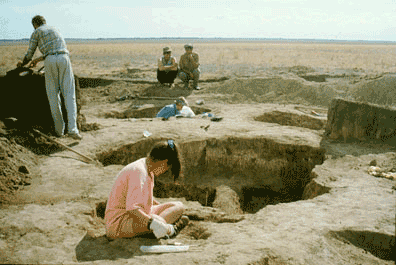
Fig. 4.Excavating a kurgan, which contained several nomadic burials. The cemetery is located in the southern Ural steppes near the Ilek
The nomads, who performed their burial rituals between the sixth to the second centuries BCE, worshipped nature gods with a goodly admixture of shamanism. They also maintained a strong belief in the Otherworld. As such, they felt it necessary to not only include food provisions with the deceased for the journey to the Otherworld but to provide for the future life by placing accoutrements in the burial that had been used by the deceased during his or her lifetime. The profusion of artifacts in the burials, along with the ethnographic information collected from Kazak tribes in the Altai Mountains, provided sufficient information to allow me a glimpse into the lives of the Early Nomads. It should be remembered that only non-organic materials were preserved in the burials and, in addition, the soil in this region preserved bronze but was extremely detrimental to the iron arrowheads, daggers, and swords. The burials would have been a treasure trove of cultural content if the leather, felts, textiles, woodcarvings, and such had been available for study. However, the profusion of non-perishables still revealed much about these nomads, including the status and rank of many of women during their lifetimes.
To verify that the statuses of women in the southern Urals were not a local phenomenon, I gathered a small team together and we drove from Rostov na-Donu, in southern Russia to Ufa the capital of Bashkortostan, stopping at museums in Kalmykia, in the Azov region, and many more along the Volga River. The materials on display and in the museums’ storages revealed that the nomads maintained the same statuses or ranks within the Sauromatian and Early Sarmatian periods in the Don-Volga interfluvials as they had in the southern Ural steppes. As strict data had not been kept on the thousands of Russian and Soviet excavations that took place beginning in the 19th century until present time, the approximate percentages of each status within these populations is unclear.
Compilation of data from four years of excavations at Pokrovka, however, indicated that priestesses were 7% of the population, warrior-women 15%, warrior-priestesses 3%, while women of the hearth held the majority at 75%. In 2002, double blind DNA testing was accomplished on a number of female skeletons from Pokrovka. This revealed that the sex of each person in the study was consistent with that as had been previously determined by physical anthropological means using the pelvis and cranium for sexing. Nomads buried at Pokrovka are considered middle-class as almost all have valuable artifacts in the burials and only a very few (2-3 in number) have no grave offerings beyond a pot and a small amount of meat as indicated by animal bones. Yet no large “tsar” kurgans are found among these cemeteries. The closest great kurgans, known as Piat Bratya (Five Brothers), are located ca. 7-10 km west of Pokrovka. These have been extensively robbed (probably several times) and never excavated so it is not know if they belong to the Pokrovka group.
As revealed by the large number of artifacts in the Pokrovka burials, primarily imported beads, pottery, and spindlewhorls, including pseudo-spindlewhorls carved from chalk, many of the hearth women must be considered above average in wealth for the time period. They were, therefore, women whose rank within their society was relatively high. The presence of pseudo-spindlewhorls, implies that in ancient times spinning must have had a special significance, possibly even of a mystical nature. It may not be a coincidence that there are mythic connotations tied to fairy tales, such as spinning straw into gold.
A priestess was identified by her possessions that heralded a bronze mirror, probably a kubok (ceremonial vessel), and fossilized seashells. Although we don’t know the source of the fossilized seashells excavated at Pokrovka, they may have been used as containers for mixing ground colored ores, used for ceremonially painting symbolic designs on her body, tattooing, or painting on fabric. I have observed all these techniques and practices on mummies related to the nomadic culture and their artifacts on display in the Archaeological Museum in Xinjiang, western China. Or the shells as well as the mirrors might have been used for scrying, the art of seeing spirits or hearing voices from the Otherworld.
Depending upon their level of proficiency (as “training” was certainly necessary), nomadic women, as priestesses, were sought to perform many rites of passage within the family, clan, or tribe as well as to attending to gods or even possibly representing a goddess. Priestesses also performed prognostications and divinations that resulted in decisions benefiting the welfare of group within which they worked—whether it be aul, tribe, or confederacy. The highest of all female statuses were warrior-priestesses, determined by artifacts representing a priestess and a warrior. Their burials, as we will see later, could be affluently appointed.
The orientation of a burial reveals the deceased tribal affiliation. Sauromatians, dating to around 6th-4th centuries BCE, are oriented north-south while the Early Sarmatians dated to around the 4th-2nd centuries BCE, are placed east-west (there are three period of Sarmatians: Early, Middle, Late). Another identifying factor is that iron trilobite arrowheads begin to appear in numbers during the Early Sarmatian period while before that time only bronze trilobite arrowheads were in play. There is also a difference in the physiognomy of the two cultures: the Sauromatians tend to be larger boned and taller than the Sarmatians. This seems to point to the fact that they were not necessarily genetically related and probably originated in different lands. Their relationship is that they used the same burials grounds as the Sarmatians definitely were not averse to burying their deceased in a Sauromation kurgan, a kurgan most often originally built for a female of high rank.
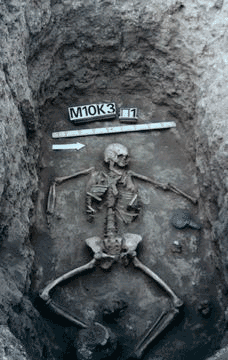
Fig 5. The lady excavated from Cemetery 10 at Pokrovka, was elderly
and frail when she died. As the most ancient of nomads, she has only a
bronze mirror and one seashell among her offerings
The earliest dated priestess that we excavated at Pokrovka, a Sauromatian, was offered minimalist contributions to her burialfor these first nomads had not yet gained the affluence found in later-dated nomadic burials. In contrast, an Early Sarmatian priestess, dated around 200 years later and also buried at Pokrovka had artifacts that included gold conical-shaped temple pendants; a kubok (sometimes referred to as a kurilnitza) four large fossilized seashells; a ceremonial (or sacrificial) stone-carved altar, 12”-15” long; a large bronze mirror, clear and smooth on the face to assist in divinations, but engraved on the reverse with an abstract design; and beads carved of a variety of imported semi-precious stones and amber from the Baltic. Most importantly in recognition of her rank were three gold feline attachments (Figure 6) worn at her neckline (Figure 7).
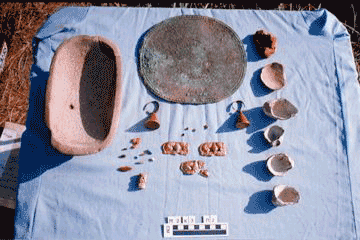
Fig. 6. Artifacts from a Pokrovka Priestess burial included (from
left) a stone-carved ceremonial altar, a bronze mirror, an amulet, and
five fossilized seashells. Below the mirror, two gold temple pendant,
beads from stone and amber, three gold feline figurines and below, a small
carved female figure of a type found in Eastern Europe. A larger (about
7 inches in height) similar statue was excavated from yet another female
burial at Pokorvka
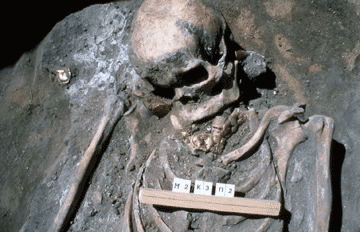
Fig. 7. Pokrovka Priestess in-situ; two feline plaques lie on her upper chest and a third is off to her right, possibly drug there by a small suslik, a ground squirrel type rodent indigenous to this area
Warrior-women’s burials contained many of the same types and styles of artifacts in various quantities as those of the hearth women with the important addition of bronze arrowheads and frequently other armament such as an akinakes (short sword), an iron dagger (Figure 9), and/or very long iron swords, and occasionally, iron armor elements.
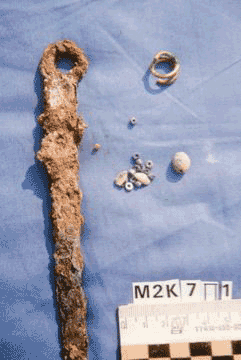
Fig. 8. An iron akinakes or short
dagger excavated from a Pokrovka female burial
Warrior-priestesses had a greater status, combining the attributes of both the priestess and warrior. Training began early for it would have taken many years for the great warrior-priestess to reach the high status that some enjoyed. This point is illustrated with the excavation of a 16-year old whose burial contained an akinakes, two amulets of prowess, 40 arrowheads, and seashells (even an imported stone that was naturally formed into a pseudo-seashell), yet her burial did not contain the gold associated with a great warrior-priestesses (Figs 10, 11, and 12). Figure 9shows a contemporary Mongolian archer (representing a warrior) with a seashell hung from her waist (representing a priestess).
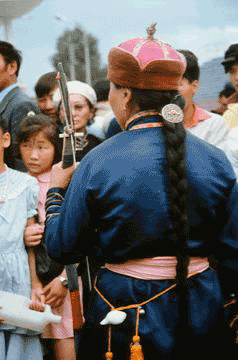
Fig. 9. A Mongolian archer at the annual Naadam celebration in Ulanbaatar wears a seashell strung on a gold cord around her waist. Significance of seashells in first millennium BC burials is not clear.
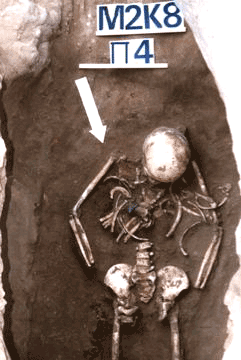
Fig. 10. This 16-year warrior-priestess wore an amulet around her neck made up of a bronze arrowhead placed in a leather pouch (the green color in the photo caused by oxidized (patina) bronze
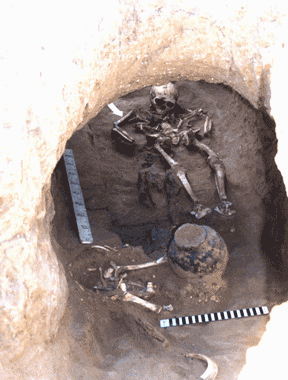
Fig. 11. The warrior-priestess was buried in a catacomb, which collapsed hear her head allowing lighting of the burial. The akinakes and arrowheads are to the right of her lower leg. A second amulet, a drilled boar’s tusk, was also among her offerings
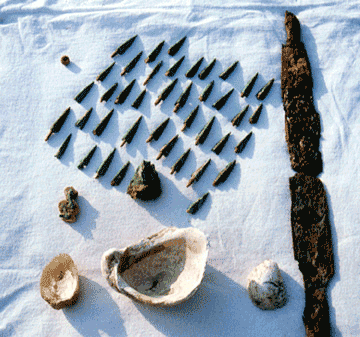
Fig. 12. Bronze arrowheads, an iron akinakes, and an amulet containing a bronze arrowhead attest to her prowess as a warrior. The two natural seashells and the pseudo-seashell containing a white substance, probably used as a paint, attribute to her priestess’ being
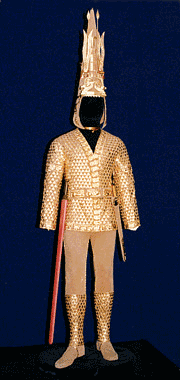
Fig. 13. The Issyk Warrior-Priestess, as reconstructed by the Institute of Archaeology, Almaty (formerly Alma Ata), Kazakstan. Subsequent excavations and research indicate she probably wore a skirt. Soft boots are still worn by the nomads
A great warrior-priestess is one such as excavated from Issyk in southern Kazakstan (Fig. 13). Her semantically loaded belt plaques incorporated zoomorphic juncture, a term that explains the casting of a combined feline with a bird head and a rack of deer horns (Figure 14). Felines, in less than passive posture and positioned as if they were on mountains, were attached to her conical hat (Figure 15). One would surmise that, as she performed her various important duties for the tribe, these powerful creatures of nature were her animal helpers. It is probably not a coincidence that the image of a feline, the Tien Shan snow leopard in naturalistic form, was carved on a rock outcropping at Maimak, located not far from Issyk in southern Kazakstan (Figure 16).
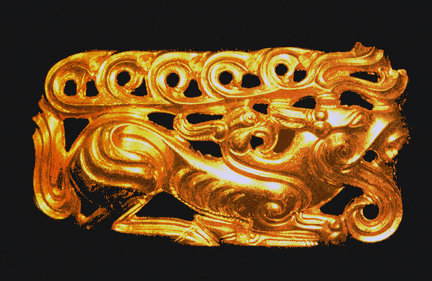
Fig. 14. The Issyk Warrior-Priestess wore belt plaques whose symbology
included the prowess of a feline, the flight of a bird, and the suavity
of deer horns sweeping over a single creature’s back. Could it be that
by combining all these attributes, this zoomorphic creature would have
triple the power?
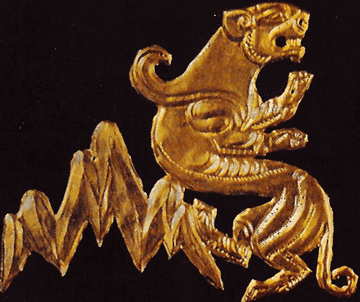
Fig. 15. One of several gold felines attached to the sides of the Issyk Warrior-Priestess’ tall conical hat, a sign of high status. Other small gold icons included the Tree of Life with small birds resting on its branches. The small birds were believed to be souls waiting to be born. The combined iconography would imply the Warrior-Priestess was also responsible for continued fecundity within the Tribe.
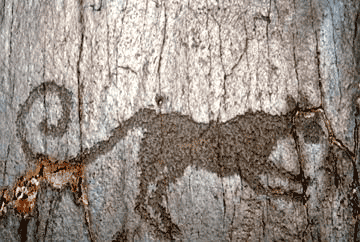
Fig. 16. image of a Tien Shan snow leopard (identifiable by its
tail curled at the end) was cut into a steeply sloping rock outcropping
at the petroglyph site, Maimak, located within miles of Issyk.
Powerful images in gold, cast in the form of great felines, were also found in the burials of priestesses and warrior-priestess over a wide territory. The belief system incorporated in this powerful animal may indicate a loosely defined confederacy of priestesses, who enjoyed historical, hereditary, and contemporary contact, employing near-identical iconic powers. These ladies of prestige surely dominated the steppes from Pazyryk and Ukok in the Gorny Altai region of southern Siberia (Russia) to Issyk in southern Kazakstan, further south in the neighboring Xinjiang province of western China (old Turkestan); and northwest beyond Pokrovka to a more recently re-excavated kurgans at Prokhorovska, Russia. This latter burial contained the skeleton of a single woman and her offerings included iron arrowheads, gold medallions for her tunic as well as ample space in the burial for her now-lost conical hat, a symbol of high status among nomadic women. This excavation was featured in the PBS documentary “Secrets of the Dead: Amazon Warrior Women.”
It is not possible in such short space to synthesize the location of the burials and quantity of artifacts that reveal just the most highly influential priestess and warrior-priestess across the steppe lands. However, such individuals, several who lived and died and were buried in a single locale, in northern Afghanistan, present the most interesting glimpse into the rich history of priestesses and warrior-women. Their story begins with a series of historical events.
The Tillya Tepe Priestesses and Warrior-Priestesses
We must first start in China, when the powerful nomadic Hsiung-nu confederacy maintained such severe military pressure upon them that the Chinese constructed the Great Wall. Turning their interests elsewhere, the Hsiung-nu advanced upon the five tribes of the Yüeh-chih confederacy, who were nomadizing in pastures adjacent to the Silk Road in western China, Xinjiang province, and in the Tien Shan Mountains. The Yüeh-chih, in turn retreated, migrating westward arriving around 135 BCE in Bactria, northern Afghanistan. Here, they made their home along the Oxus River (now the Amu Darya) where they subjugated the local inhabitants. About a century later, the confederacy came under the domination of a single chieftain, who later founded the widespread Kushan Empire that fostered the spread of Buddhism throughout Asia. The early images of Kushan Buddhism reveal the nomadic influence in this religion: Bodhisattvas and deities wear the accouterments of the nomadic women of high status, long skirts, large headdresses, and great strands of beads or torques (Figure 17) (Rosenfield 1967).
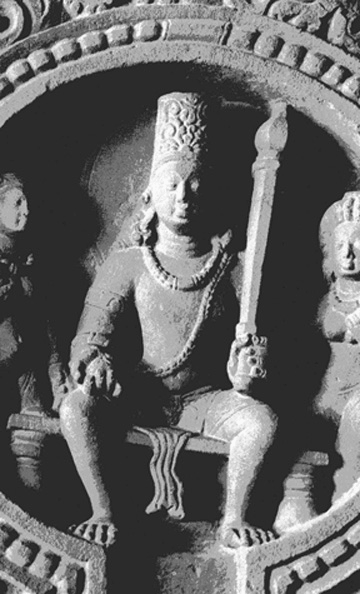
Fig. 17. Figure 13. Enthroned Yama, Bhumara. The Yama was a source of royal authority. (After Rosenfeld, Plate 165).
Returning to present day in northern Afghanistan, Tillya Tepe (translated as Gold Mound) located along the Amu Darya, was excavated. This mound had seen numerous people and cultures come and go since its initial construction more than three millennia ago. Its lowest layer had been a fire temple with a columned hall surrounded by fortified towers, a construction associated with Zoroastrianism. Built before 1000 BCE, it continued to be in use until it was laid waste, then magnificently rebuilt in the middle of the first millennium BCE. Sometime afterward a fire demolished the structure so that when Alexander the Great and his army marched through around 328 BCE, they found only ruins. A couple of centuries later when the Yüeh-chih confederacy controlled this territory—and it may well have been the consolidating chieftain that gave Tillya Tepe its new role—the ancient fire temple became the final resting place for the most prestigious of Yüeh-chih religious leaders. Their burial site follows the nomadic tradition of reusing ancient monuments for interment—as we have seen many instances in the kurgans at Pokrovka as well as in the Altai Mountains where contemporary Kazaks follow ancient traditions by constructing their mausoleums within the confines of an ancient kurgan cemetery.
Sarianidi excavated six burials from near the surface of the Tillya Tepe mound. [2] The artifacts made it possible to discern that of the five females buried, ages 15 to 30, three were priestesses and two were warrior-priestesses. The weather became so severe in early November of that year that the work had to be discontinued for the season. The following spring the Afghan-Russian war was in full bore and Sarianidi was not able to return to complete the Tillya Tepe excavations. An ancient mirror, however, was among merchandise offered the following spring in the Kabul bazaar; this artifact implies that looting of the mound had taken place during the winter and that a sixth personage, another priestess, also had been buried at Tillya Tepe.
In addition to the five females excavated, a single male, age 30, was also identified with artifact revealing that he had assumed attributes of a warrior-priestess. This would lead to the conclusion that he was a eunuch or Enaree, the latter a male, according to Herodotus who had “developed a female sickness” after pillaging the temple of Aphrodite in Ascalon, Phoenicia (Herodotus IV: 67). So it was impossible to determine if this lone male were an Enaree or an eunuch for without soft tissue, which of course had been completely lost, there would be no way to determine whether or not he had been emasculated.
Incredibly, the Tillya Tepe burials contained more than 20,000 beautifully cast gold and polychromic (encrusted) pieces, each with its own history. And, of course, as with all ancient gold treasures, they have much more value than that of their gold. Moreover, tales of hijacking and theft, murders and other gory anecdotes increase the value of the artifacts as well as increasing the world’s fascination with Archeology. The treasures of Tillya Tepe were no exception, as during and after the Russian/Afghan war, they became the center of a mystery, a saga that provided even more added value.
Their story as quoted by an on-line journal follows:
“These (Tillya Tepe) treasures and many others were tragically lost when the Kabul Museum was bombed in 1993. At first, only the upper galleries suffered losses and looting. The remaining artifacts were transferred to lower leveled, steel-doored vaults. In 1994, the United Nations attempted to stop the looting by repairing the doors, and bricking up the windows. Disappointingly, these attempts failed, and looters continued to plunder 90% of the museum's collections. Both private collectors and antique dealers from as far away as Tokyo have purchased stolen museum pieces. Looted artifacts have shown up all over the world, and they bring in large sums of money to the criminals.
(Afghanistan On Line, “Kabul Museum,” http://www.afghan-web.com/kabul-museum/intro.html.)
But the story has a happy ending. According to a New York Times, near the end of the Soviet occupation of Afghanistan, 22, 513 objects had been moved from the museum and hidden away. The Tillya Tepe artifacts, noted as the most valuable pieces, had been stored in the presidential palace compound and were returned to the museum in 2004. (C. Gall, “Trove of Afghan antiquities ‘lost’ since ‘80s had been secreted away to Kabul storage,” New York Times.)
So important stylistically to illustrate now obscure historical contacts, the Tillya Tepe treasures represent six different cultural associations: the second millennium BCE Bronze Age Bactria followed by Greco-Bactrian and Greco-Roman; the Early Iron Age is represented by the local Bactrian tradition, a Siberian-Altai (Saka) Animal Style, and Scytho-Sarmatian Animal Style. (Sarianidi, The golden horde of Bactria, 53.) In addition, the extraordinary iconography provides many clues as to cultural affinities, nomadic belief systems, and not least of importance, the continuing statuses of priestesses and warrior-priestess within a nomadic confederacy of high standing.
The multitude of artifacts found in the burials and associated with priestesses’ burials 1, 5, and 6 include mirrors, colored chalk, and objects semantically loaded with fertility ritual iconography. The warrior-priestesses accoutrements in burials 2 and 3, in addition to priestess artifacts such as those related to fertility, included a Kushan Aphrodite and Venus-like images, an amulet of Athena in warrior stance and several daggers from various locales. The warrior-priestess in burial 3 had worn a belt in which the two plaques depicted a warrior, resplendent with a long sword, akinakes, and round Bactrian shield but dressed with the flair of Greek femininity (Figure 18). (See Davis-Kimball, 1999 for a table of status/artifact correlation.)
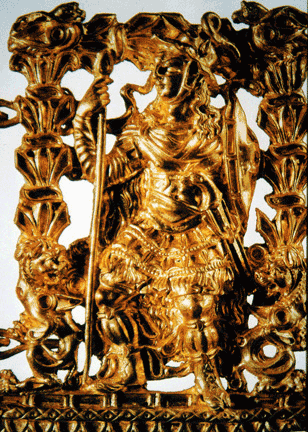
Fig. 18. Belt Clasp with representation of a warrior-woman (?)
or Enaree, Burial 3, Tillya Tepe. (After Sarianidi, The golden hoard of
Bactria, Plate 84.)
As reconstructed by the archaeologists, the male in burial 4 had been in similar costume as that worn by the females: a belted V-necked caftan over a long skirt or pants. His artifacts were those of the nomadic warrior-priestess: dagger and sword, another Kushan Aphrodite, a kubok, and a gold Tree of Life. But more interestingly, his gold belt was assembled from nine lost-wax cast medallions secured with chains. Each medallion displays a female riding sidesaddle on a ferocious feline (Figure 19). Although stylistically similar to an image from the same northern Afghanistan region dated two millennia earlier, (Davis-Kimball, 1999, 2000), here the serenity of the seal image has been replaced by Cybeleius intensity, expressed by the utmost mastery of a powerful feline and display of supreme feminine power.
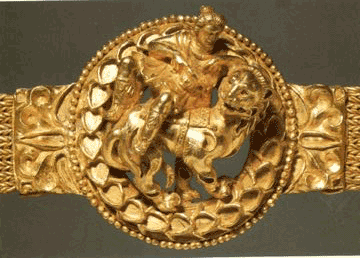
Fig. 19. One medallion from the belt buckle of the male at Tillya Tepe, Burial 4, illustrating a female riding sidesaddle on a lion. (After Sarianidi, The golden hoard of Bactria, Plate 88-97.)
Although the distances are vast, within the Tillya Tepe collection much of the iconography and stylization of the artifacts of these priestesses and warrior-priestesses have a distinct Eurasian nomadic flavor with the semantics indicating, as would be expected, complete feminine power with physical control.
Summary
In spite of the fact that distances are vast, within the Tillya Tepe collection much of the iconography and stylization of the artifacts of these priestesses and warrior-priestesses have a distinct Eurasian nomadic flavor with the semantics indicating, as would be expected, complete feminine power with physical control
While extrapolating ethnographic information and illustrating some of the more seminal excavation materials, we have gathered a few of the concepts of the ancient nomadic belief systems as well as illustrating the statuses of women in their societies. Our ladies of high rank held many functions that included fighting in battle, healing, and officiating at the most important rites of passage. One could well imagine, also, that a few of them provided prognostications for their chieftains; an influence that would have been widely felt throughout the confederacies. Their contributions to ancient societies in that vast steppe-land should never be underestimated. They were absolutely necessary for tribal survival.
Bibliography
Afghanistan On Line. “Kabul Museum.” http://www.afghan-web.com/kabul-museum/intro.html
Aruz, Joan, Ann Farkas, Andrei Alekseev, and Elena Korolkova, Eds. 2000.The Golden Deer of Eurasia: Scythian and Sarmatian Treasures from the Russian Steppes. New York: The Metropolitan Museum of Art,
Auerback, Jens, director and Carsten Oblander, producer. 2004.“Secrets of the Dead: Amazon Warrior Women.” Washington D.C. and Berlin: Story House Productions,
Barbarunova, Zoya A. “Early Sarmatian Culture. 1995.” In Nomads of the Eurasian Steppes in the Early Iron Age, edited by Jeannine Davis-Kimball, Leonid T. Yablonsky, and Vladimir Bashilov, 121-131. Berkeley: Zinat Press,
Burger, Joachim. “Report on Warrior Women,” “DNA Report (on) Pokrovka Warrior Women Compared to Meriamgul.” http://csen.org/DNA_Report/DNA.html nd.
Boykova, Elena. “Funeral Rites in Eurasian Shamanism. 2004.” In Shamanism: An Encyclopedia of World Beliefs, Practices, and Culture, edited by Mariko N. Walter and Eva Jane Neumann Fridman, 557-564. Santa Barbara, Denver, and Oxford, England: ABC-CLIO
Davis-Kimball, Jeannine. “Filippovka's ‘Poor Relatives’: Ancient and Modern Eurasian Nomads.” In Nomads of the Eurasian Steppe, Golden Deer of Eurasia Symposium. New York: Metropolitan Museum.
Davis-Kimball, Jeannine. 2004.“Priestesses of Ancient Eurasia.” In Shamanism: An Encyclopedia of World Beliefs, Practices, and Culture, edited by Mariko N. Walter and Eva Jane Neumann Fridman, 601-608. Santa Barbara, Denver and Oxford, England: ABC-CLIO
Davis-Kimball, Jeannine 2002. Warrior Women: An Archaeologists Search for History’s Hidden Heroines. New York: Warner Books.
Davis-Kimball, Jeannine. 2001.“Village Life to Nomadism: An Indo-Iranian Model in the Tien Shan Mountains (Xinjiang, China).” In Proceedings of the Twelfth Annual UCLA Indo-European Conference Los Angeles May 26-28, 2000, edited by Karlene Jones-Bley, Angela Della Volpe, Miriam Robbins Dexter, Martin E. Huld, Journal of Indo-European Studies Monograph Series, No. 40, 243-268. Washington, D.C.: Institute for the Study of Man
Davis-Kimball, Jeannine. 2001. “Fertility Rituals: The Kangjiashimenzi Petroglyphs and the Cucuteni Dancers.” In Material, Virtual, and Temporal Compositions: On the Relationship between Objects, edited by Dragos Gheorghiu, 27-44. Papers from a session held at the European Association of Archaeologists Fifth Annual Meeting in Bournemouth 1999, British Archaeological Research Reports, International Series 953. Oxford: Archaeopress,
Davis-Kimball, Jeannine. “Enarees and Women of High Status.” In Kurgans, Ritual Sites, and Settlements: Eurasian Bronze and Iron Age, edited by Jeannine Davis-Kimball, Eileen Murphy, Ludmila Koryakova, and Leonid Yablonsky, British Archaeological Research Reports, International Series 890, 223-229. Oxford: Archaeopress, 2000. Available on The Internet site, Center for the Study of Eurasian Nomads, http://www.csen.org/csen.tofc/csen_tofc.html.
Davis-Kimball, Jeannine. 1999. “Priestesses, Enarees, and Other Statuses Among Indo-Iranian Peoples.” In Proceedings of the Tenth Annual UCLA Indo-European Conference: Los Angeles, May 21-23, 1998, Journal of Indo-European Studies Monograph Series number 32, edited by Karlene Jones-Bley, Martin E. Huld, Angela Della Volpe, and Miriam Robbins Dexter, 231-259. Washington, D.C.: Institute or the Study of Man
Davis-Kimball, Jeannine. 1998.“Statuses of Eastern Early Iron Age Nomads.” In Papers from the EAA Third Annual Meeting at Ravenna 1997. British Archaeological Reports, International Series 717, 142-149, edited by Mark Pearce and Maurizio Tosi. Oxford: Archaeopress
Davis-Kimball, Jeannine. 1997. “Sauro-Sarmatian Nomadic Women: New Gender Identities.” In Journal of Indo-European Studies, volume 25, numbers 3 & 4, Fall/Winter, 327-344. Washington, D.C.: Institute for the Study of Man
Davis-Kimball, Jeannine. 1997.“Chieftain or Warrior Priestess?” Archaeology Magazine, 40-41. New York: Archaeological Institute of America, Sept/Oct
Jeannine Davis-Kimball, Leonid T. Yablonsky, and Vladimir Bashilov, Eds. 1995. Nomads of the Eurasian Steppes in the Early Iron Age. Berkeley: Zinat Press,
Gall, Carlotta. “Trove of Afghan antiquities ‘lost’ since ‘80s had been secreted away to Kabul storage,” New York: New York Times.
Gimbutas, Maria. 1991.The Language of the Goddess. New York: HarperCollins Publishing
Herodotus. Translated by A.D. Godley. Loeb Classical Library, Cambridge: Harvard University Press.
Khazanov, Anatoly M. Translated by Julia Crookenden. 1994.Nomads and the Outside World. Madison: University of Wisconsin Press
Kimball, Jeannine D. , 2002.“The Nomadic Kazaks of Western Mongolia.” In The Turks, volume 6, 697-706, edited by Hasan Celâl, Güzel, C. Cem Oguz, and Osman Karatay. Ankara: Yenî Türkîye Publications
Korolkova, Elena. “Ritual Vessels of the Nomads.2000.” In The Golden Deer of Eurasia: Scythian and Sarmatian Treasures from the Russian Steppes, edited by Joan Aruz, Ann Farkas, Andrei Alekseev, and Elena Korolkova, 61-66. New York: The Metropolitan Museum of Art,
Ligabue, Giancarlo and Sandro Salvatori, Eds. Bactria:1988. An Ancient Oasis Civilization from the Sands of Afghanistan. Venezia: Erizzo,
Moshkova, Marina. 1995. “History of the Studies of the Sauromatian and Sarmatian Tribes.” In Nomads of the Eurasian Steppes in the Early Iron Age, 92-93, edited by Jeannine Davis-Kimball, Leonid T. Yablonsky, and Vladimir Bashilov. Berkeley: Zinat Press
Murphy, E. M. and J. Davis-Kimball. 2002 (2001 volume).“Weapon trauma on Bronze Age human skeletal remains from the Chowhougou cemeteries.” Journal of Palaeopathology 13, 27-34.
Polosmak, Natalia. 1994.“A mummy unearthed from the pastures of heaven,” National Geographic, 89-103. Washington D.C.: National Geographic Society, October
Polosmak, Natalia. “La prêtresse altaåque. In Tombes gelées de Sibérie, 212, edited by B. Bioul, A. Jeannelle, H. Durand, and V. Maily, 28-35. Dijon: Editions Faton SA, 1996.
Purev, Otgonu. 2004.“Darkhad Shamanism (Mongolia).” In Shamanism: An Encyclopedia of World Beliefs, Practices, and Culture, edited by Mariko N. Walter and Eva Jane Neumann Fridman, 545-547. Santa Barbara, Denver and Oxford, England: ABC-CLIO
Rosenfield, John M. 1967.Dynastic Arts of the Kushans. Berkeley: University of California. Press
Rudenko, Sergei I. Translated by M.W. Thompson. 1970. Frozen Tombs of Siberia: The Pazyryk Burials of Iron Age Horsemen. Berkeley and Los Angeles: University of California Press
Sarianidi, V.I. Translated by Arthur Shkarovsky-Raffe. 1985.The golden horde of Bactria: From the Tillya-tepe excavations in northern Afghanistan. New York: Abrams
Wilson, Mary Lynn. 2001.“The Bird Goddess in Germanic Europe.” In Proceedings of the Twelfth Annual UCLA Indo-European Conference Los Angeles May 26-28, 200, Journal of Indo-European Studies Monograph Series, No. 40, edited by Karlene Jones-Bley, Angela Della Volpe, Miriam Robbins Dexter, Martin E. Huld, 233-242. Washington, D.C.: Institute for the Study of Man,
Biography
Jeannine Davis-Kimball is an archaeologist and author specializing in ancient and modern cultures of Central Asia. Before receiving a Ph.D. in Art History and Archaeology from the University of California, Berkeley, she established the Center for the Study of Eurasian Nomads (CSEN). She was the first American archaeologist to excavate in Kazakstan; collaborative excavations in Russia revealed first millennium BCE high status priestesses and warrior-priestess. Davis-Kimball has appeared in eight documentaries, authored Warrior Women: An Archaeologist’s Search for History’s Hidden Heroines, more than 50 articles, and co-edited several volumes on Eurasian archaeology. She has lectured internationally and writes for and maintains the CSEN website http://www.csen.org.Center for the Study of Eurasian Nomads. 2158 Palomar Ave. Ventura, CA, 93001 USA, 805 653-2607
[1] The Kazak-American Research Project, Russian Division (later changed to the American-Eurasian Research Project, Inc., Center for the Study of Eurasian Nomads) led by Jeannine Davis-Kimball, and the Russian Institute of Archaeology, Moscow led by Leonid T. Yablonsky.
[2] Excavated in 1978-79 by V.I. Sarinidi of the Soviet Institute of Archaeology in conjunction with archaeologists from Afghanistan.
![]()
labrys,
études féministes/ estudos feministas
juillet/décembre 2012 - julho /dezembro 2012